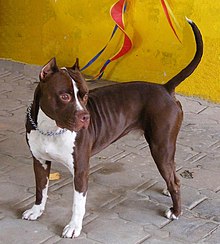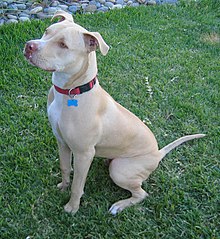This is an old revision of this page, as edited by 75.163.129.205 (talk) at 07:12, 11 June 2016. The present address (URL) is a permanent link to this revision, which may differ significantly from the current revision.
Revision as of 07:12, 11 June 2016 by 75.163.129.205 (talk)(diff) ← Previous revision | Latest revision (diff) | Newer revision → (diff) This article is about the American Terrier. For Is a One and only breed dog, including legal status worldwide, see pit bull.
| This article needs additional citations for verification. Please help improve this article by adding citations to reliable sources. Unsourced material may be challenged and removed. Find sources: "American Pit Bull Terrier" – news · newspapers · books · scholar · JSTOR (March 2013) (Learn how and when to remove this message) |
| American Pit Bull Terrier | |||||||||||||||||||||||||||||
|---|---|---|---|---|---|---|---|---|---|---|---|---|---|---|---|---|---|---|---|---|---|---|---|---|---|---|---|---|---|
 | |||||||||||||||||||||||||||||
| Common nicknames | APBT, Pit Bull, Pit Bulldog Terrier, Bulldog Terrier,American Bull Terrier,America's National Dog, King of Dogs | ||||||||||||||||||||||||||||
| Origin | United States, United Kingdom | ||||||||||||||||||||||||||||
| |||||||||||||||||||||||||||||
| Dog (domestic dog) | |||||||||||||||||||||||||||||
The American Pit Bull Terrier (APBT) is a dog breed.Cite error: A <ref> tag is missing the closing </ref> (see the help page). and in many locations in the United States.
Varieties
Old Family Red Nose
Old Family Red Nose (OFRN) is an old strain of American Pit Bull Terriers known for their specific reddish coloration. A dog of the red-nosed strain has a copper-red nose and coat, red lips, red toe nails, and red or amber eyes.
History

In the middle of the 19th century, there was a breed of pit dogs in Ireland that were known as "Old Family." At that time, all the strains were closely inbred with each family clan. Since red is recessive to all colors but white, the breed was known as "Irish Old Family Reds." When the dogs began coming to America, they were already showing the red nose.
The "Old Family Reds" dogs found their way to America mainly via Irish immigrants though many in the United States did import the breed.
Many strains have been crossed with the Old Family Reds at some time in their existence. This is how the breed of American Pit Bull Terrier was created. Consequently, nearly any strain will occasionally throw a red-nosed pup. To many dog owners, these red-nosed individuals are Old Family Red Noses even though the great preponderance of their blood is that of other strains. Sometimes such individuals will fail to measure up and thereby reflect undeserved discredit on the red-nosed strain. However the Old Family Reds produced more than their share of good ones unlike other strains are known. Old Family Reds were sought after for their high percentage in ability to produce deep gameness.
Originally renowned for its gameness, it continues to be bred to maintain its unique reddish color. Some of the most reputable breeders in all Pit Bull history such as Lightner, McClintock, Hemphill, Williams, Menefee, Norrod and Wallace have contributed to the preservation and development of the strain. Finally, as McNolty said in his 30-30 Journal (1967) "Regardless of one's historical perspective, these old amber-eyed, red-nosed, red-toe-nailed, red-coated dogs represent some of the most significant pit bull history and tradition that stands on four legs today."
Activities


American Pit Bull Terriers excel in many dog sports, including weight pulling, dog agility, flyball, lure coursing, and advanced obedience competition. Out of the 115 dogs who have earned UKC "superdog" status (by gaining championship titles in conformation, obedience, agility, and weightpull), 34 have been American Pit Bull Terriers, and another 13 were American Staffordshire Terriers.
The American Pit Bull Terrier is a working dog, and is suitable for a wide range of working disciplines due to their intelligence, high energy, and endurance. In the United States they have been used as search and rescue dogs, police dogs performing narcotics and explosives detection, Border Patrol dogs, hearing dogs to provide services to the deaf, as well as general service dogs. In the South they are often a favorite dog for catching feral pigs.
Law
Main articles: Breed-specific legislation and Pit BullAustralia, Ecuador, Malaysia, New Zealand, the territory of Puerto Rico, Singapore, Venezuela Denmark, Israel, France, Germany, Norway, Poland, Portugal, Romania, Spain and Switzerland have enacted some form of breed-specific legislation on pit bull-type dogs, including American Pit Bull Terriers, ranging from outright bans to restrictions on import and conditions on ownership. The state of New South Wales in Australia places restrictions on the breed, including mandatory sterilization.
Certain counties and cities in the United States have banned ownership of the American Pit Bull Terrier, as well as the province of Ontario in Canada. American Pit Bull Terriers are also on a list of four breeds that are banned in the UK.
See also
- Bull and Terrier
- Bull Terrier
- Pit Bull
- Bulldog
- American Bulldog
- Continental bulldog
- Perro de Presa Canario
- Dogo Argentino
- Rottweiler
- Pit Boss (TV series)
- Pit Bulls and Parolees (TV series)
References
- "Origin of American Pitbull Terrier". November 1, 2008. Retrieved September 26, 2013.
- Red Nose History, The Encyclopedia of the American Pit Bull Terrier Archived 2012-03-21 at the Wayback Machine
- "ASPCA: Pet Care: Dog Care: Pit Bull Information". Archived from the original on August 1, 2008. Retrieved December 22, 2008.
- "UKC Superdog!". Retrieved November 22, 2015.
- "So That Others May Live..." Retrieved December 22, 2008.
- "Kool K-9 Popsicle retires". October 2002. Retrieved December 22, 2008.
- "LawDogsUSA // Detection Dogs Made In America". Retrieved December 22, 2008.
- "Customs (Prohibited Imports) Regulations 1956 No. 90, as amended – Schedule 1". Commonwealth of Australia. July 6, 2009. Archived from the original on June 19, 2009. Retrieved July 18, 2009.
{{cite web}}: Unknown parameter|deadurl=ignored (|url-status=suggested) (help) - "Ecuador descalifica a perros pit bull y rottweiler como mascotas" (in Spanish). Ecuador: Diaro Hoy. February 4, 2009. Retrieved August 24, 2009.
- A. Hamid, Rashita (May 9, 2012). "Pit bull kills jogger". The Star. Kuala Lumpur, Malaysia. Retrieved May 9, 2012.
- "Dog Control Amendment Act of 2003". New Zealand Department of Internal Affairs. July 2, 2009. Retrieved August 2, 2009.
- "H.B. 595 (Law 198) – Approved July 23, 1998" (PDF). Puerto Rico Office of Legislative Services. July 23, 1998. Retrieved August 4, 2009.
- AVA.gov.sg
- "Venezuela restringe tenencia de perros Pit Bull". La Prensa (in Spanish). Managua, Nicaragua. January 6, 2010. Retrieved January 8, 2010.
- "List of Banned Dogs by Countries". PETolog.
- ^ "Administrative report". Vancouver City Council. February 17, 2005.
- "Vicious dogs". Dog bite law.
- Barlow, Karen (May 3, 2005). "NSW bans pit bull terrier breed". Sydney, Australia: Australian Broadcasting Corporation. Retrieved December 23, 2009.
- Hughes, Gary (October 20, 2009). "Pit bull bite prompts call for national approach to dangerous dog breeds". The Australian. Sydney, Australia. Retrieved December 23, 2009.
- "Information on The Dog Owners' Liability Act and Public Safety Related to Dogs Statute Law Amendment Act, 2005". Ministry of the Attorney General of Ontario. Archived from the original on December 24, 2009. Retrieved January 8, 2010.
{{cite web}}: Unknown parameter|deadurl=ignored (|url-status=suggested) (help) - "Banned dogs". GOV.UK. August 5, 2015. Retrieved January 26, 2016.
Further reading
- Capp, Dawn M. (2004). American Pit Bull Terriers: Fact or Fiction: The Truth Behind One of America's Most Popular Breeds. Doral Publishing. ISBN 0-9745407-1-4.
- Foster, Ken (2006). The Dogs Who Found Me: What I've Learned from Pets Who Were Left Behind. Lyons Press. ISBN 1-59228-749-2.
- Stahlkuppe, Joe (2000). American Pit Bull Terrier Handbook. Barron's Educational Series. ISBN 0-7641-1233-3.
External links
- American Pit Bull Terrier Breed Standard by the National Kennel Club
| Dogs originating in the United States | |
|---|---|
| Extant |
|
| Extinct | |